-
Posts
36 -
Joined
-
Last visited
Content Type
Profiles
Forums
Store
Help Articles
Posts posted by Mendel C-k
-
-
I am curious as to why people are thinking it is spleen. The spleen is a viscus, its parenchyma is spongy and trabecular and there is no "muscle" like what is on that piece of meat.
In regards to the OP, I am not sure of the answer. The caul, from my best guess looks to be omenta. In the human the greater omentum attaches the to the greater curvature of the stomach and the Spleen (as it forms from the dorsal mesogastrium) and in adults, attaches to the anteroinferior aspect of the traverscolon (though I don't know if such an event occurs in bovines). As that piece of meat looks like muscle....I would say it is some part of the abdominal wall or a pre-vertebral muscle. Although that is on the basis that it is greater omentum...which is just a guess
Edit: Wow...probably should have zoomed in...guess it is spleen after all. From the thumbnails it looked like Skeletal muscle...my bad
-
You broke it down into muscular compartments, not individual muscles...
There are some muscles in the ovine hindlimb that actually don't do much "work" so perhaps the one you cooked up was one of those.
Good job though! It is something I do regularly and I find by not disrupting the myofibrils, I loose way less moisture, while still being able to break it down into manageable pieces
-
 1
1
-
-
On 22 December 2015 at 10:45 AM, ChrisTaylor said:
Although then again, it's hard to go past black vin--the master race of condiments.
Sorry, but could you please elaborate? This has peaked my interest
-
This is one of the first recipes I created as a kid...stopped making it ages ago when I learnt I had Celiac

Make a stuffing by sautéing onion and celery in copious butter and oil (bread soaks it up). Once translucent, add stale bread pieces, chives, rosemary, sage and grated parmesan and then allow to cool.
Stuff each quail with the stuffing and then wrap in a layer of procuitto. Roast in a 180c over for 20-25m
It was enjoyed by all who ate it
-
why not portion before SV'ing?
-
 1
1
-
-
Myoglobin is what makes meat juices red.
You can call it anything you want but the red is myoglobin.
You're right. I was talking about the mixture rather than just myoglobin, which is a component of it. Sorry for the thread takeover.
In regards to duck brest, is the an optimum method to render after sous vide, and has anyone had any experience removing the skin, removing some of the fat from underneath, then readhering with TG?
-
Myoglobin is just a protein, very similar to Haemoglobin, that carries oxygen within myocytes.
Osmazome is a volatile compound that invokes umami, though it is archaic.
The sarcoplasm is the intracellular cytoplasm of myocytes and thus the main contributor to the liquid released during cooking
-
sarcoplasm I believe it's termed...
-
Chez Michel by Thierry Breton...every time I've been to Paris I go there
-
 1
1
-
-
What temp did you SV at?
-
Did beef cheeks for 60h @ 56c and final 12h at 54, finished in cast iron with ghee and served with puree of cauliflower and double extracted jus with persillade and deep fried jerky crisps.
Was good.
-
That steak is from the more caudal end and thus the "strip" portion has a smaller longissimus portion and more other muscles. Between the muscles will be thin facial membranes (that will be tough) but the larger "lines" you see are still just fat.
-
I recently came into possession of a 36 oz porterhouse and a 24 oz ribeye from Lobels.
I cannot yet speak to the flavor, but I must say, at first glance I was disappointed by the looks of the meat. The strip section of the porterhouse looks to have a thick tendon running through the middle, the color is a pinkish hue, and the marbling seems fairly average. Considering the cost was $180.00+ for these two pieces of meat, I feel a bit let down. The ribeye looks better, but nothing like picture I have seen of Lobel's in the past. For instance, the following picture was uploaded by an eGullet member as representative of Lobel's quality:
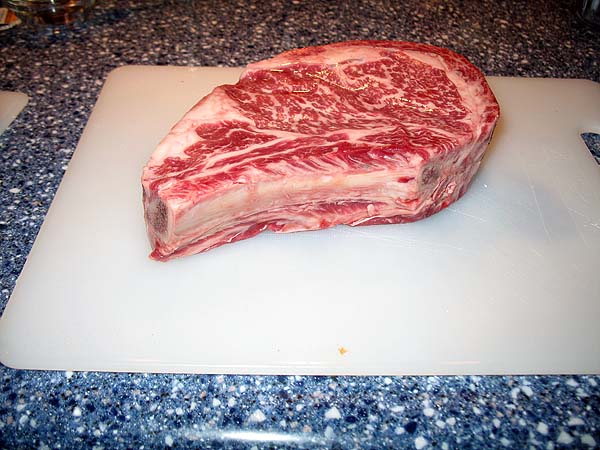
My steak does not look like that - though it is the same cut, same purveyor, and same size. That steak seems worthy of an $80.00 price tag.
Regardless, I am trying to decide how to cook these. Right now I have the porterhouse in the fridge, heavily salted. It's either sous-vide then a char on the grill, or slow cooked on the cool side of the grill basted with butter/herbs/roasted garlic and then seared up near target temp. Does anyone have any suggestions on how I should proceed?
Hmm, it would be unlikely that it is a tendon. The strip section represents the epaxial muscles and thus is actually a composition of my different muscles : Splenius, Spinalis, Iliocostalis, Longissimus, Semispinalis, Multifidus and rotatores. Which muscles are present will depend on which vertebral level the steak is taken from. A picture would help, but my guess is that it is a bit a facia between the erector spinae and transversospinalis.
-
 1
1
-
-
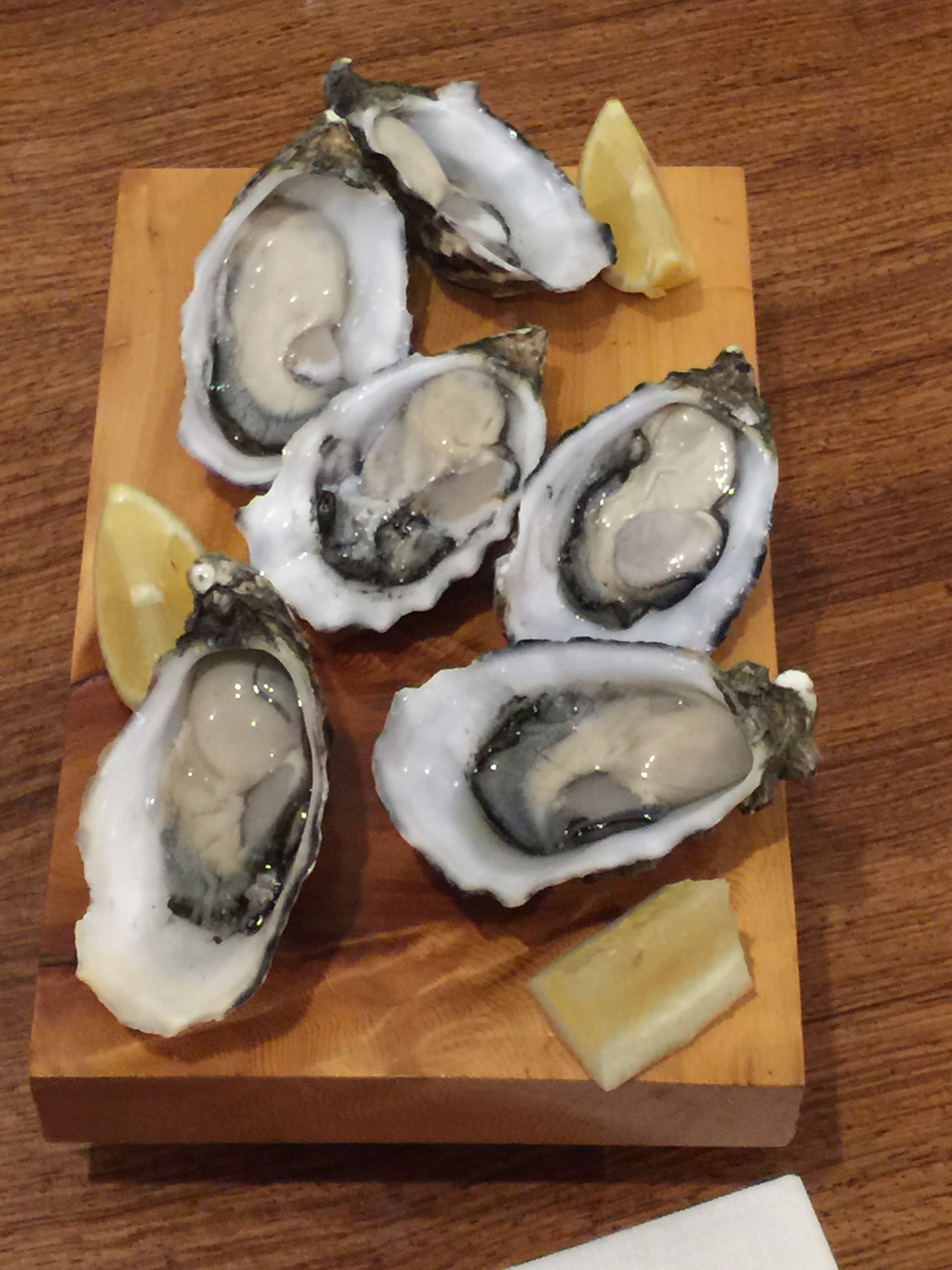
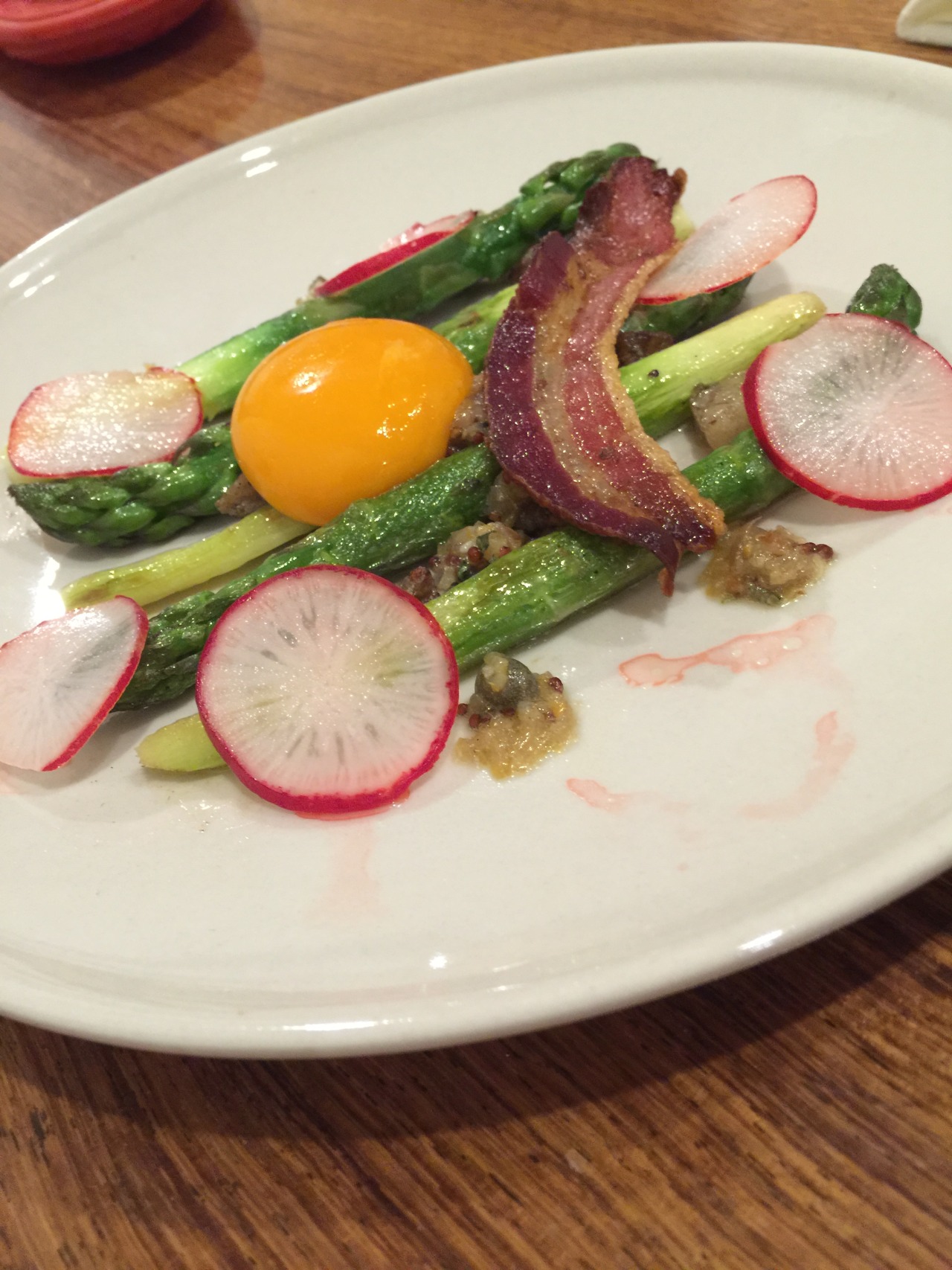
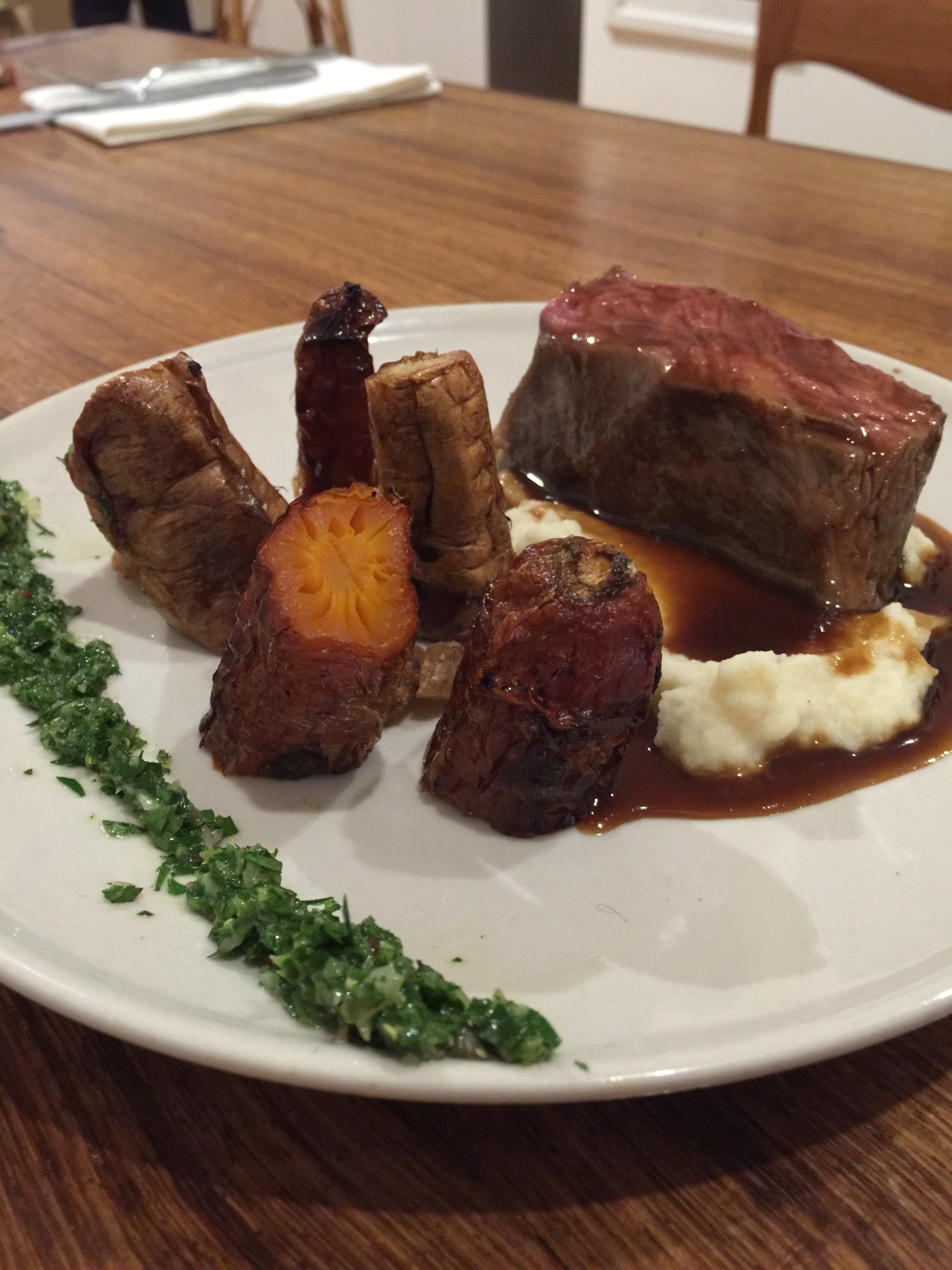
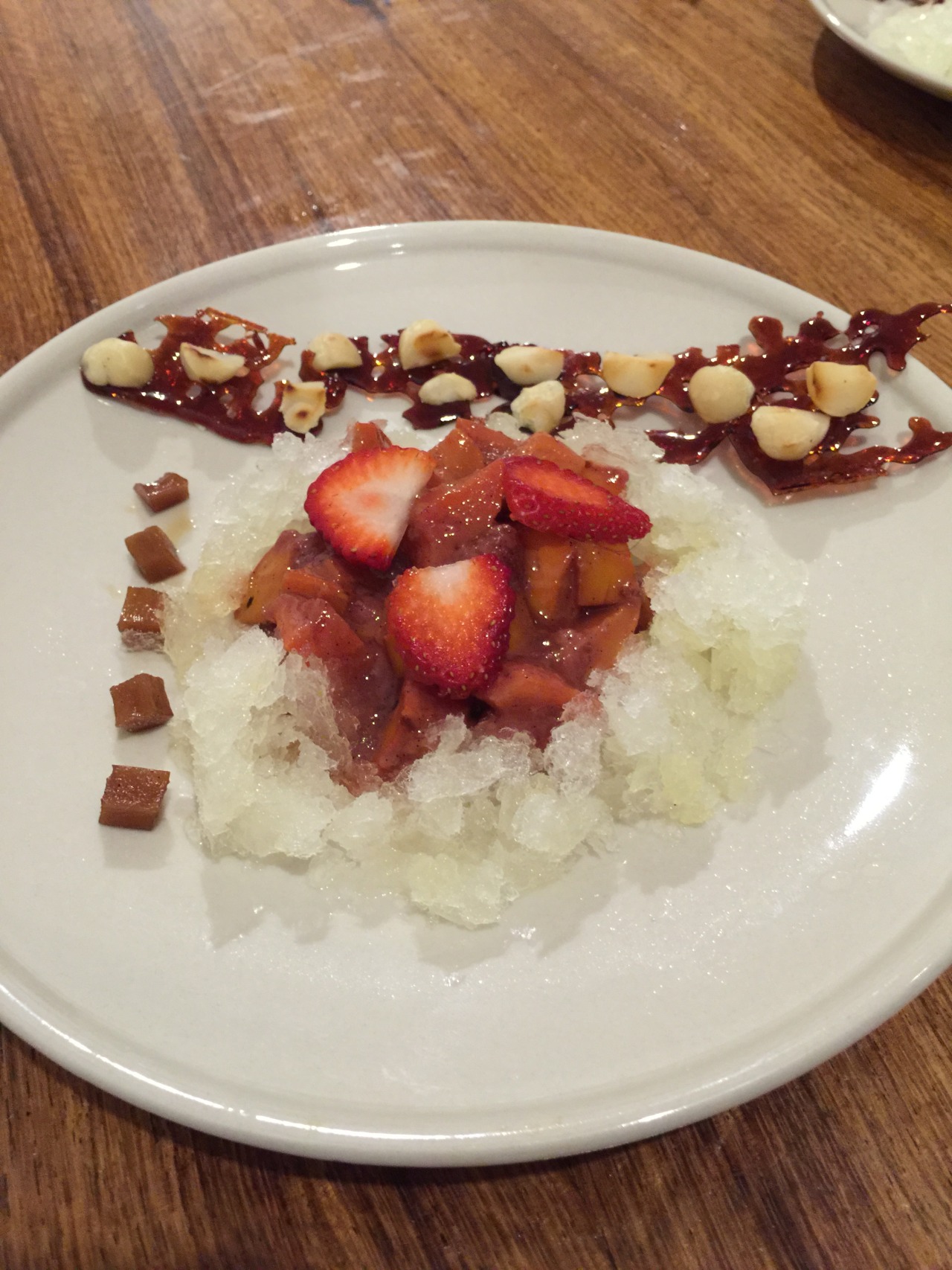
Oysters
Asparagus with Yolk, Pancetta, and Marrow Sauce (Marrow, capers, shallot, anchovy, garlic, mustard, butter, verjus) and some picked radishes
Serratus ventralis (beef rib) with cauliflower puree, demi glace, 4 hour roast carrot and parsnip, marrow, and persilade (Parsley, shallot, garlic, mustard, anchovy, capers, EVOO)
Persimmon and strawberry compote (with vanilla, ginger, nutmeg, cinnamon, orange and lemon) with gin and tonic granita, candied ginger and caramel and macadamia
Sorry about the large photos...my plating could do with some work but it tasted pretty good.
-
 6
6
-
-
Re above:
You are both right. There are vagal afferents to the area Postrema (nerves to the brain) that will cause POMC release in the hypothalamus and a very quick response to ingestion of food (measured by stomach distension). Also, when digesting in the stomach, small amounts of chyme (the stomach contents) will leak into the duodenum (small intestine), and be absorbed by the cells of the duodenal epithelium. These cause the release of CCK and GLP-1 among other peptides (the specific one will depend on what biomacromolecule was absorbed. Obviously, as these are blood born proteins, they will take longer to reach the brain and thus there is a latency between eating and satiation.
-
Oil or fats are too thin to have texture or mouthfeel IMO. Mouthfeel and/or texture comes to fats when whipped or emulsified... the finish has a flavor to me. If it didnt then Fat Free Half and Half would be satisfying, but its not...
Satiation, satisfaction and ability to sense the presence of fat is VERY different to taste.
Also - "too thin to have texture", I think if you put a knob of ghee and the same amount of water in your mouth you'd be able to sense the difference
-
Huh. I don't taste triglycerides. Peanut oil is just oily to me.
The one paper that was linked studied the perception of fatty acids which although they are lipids, are not fat per se.
Fat is triglyceride, which is a gycerol esterified to three fatty acids. Vegetable oils are ~99.9% triglyceride. Solid fat is made of triglycerides with longer carbon chains that remain solid until heated to their melting temp. Fatty acids are not free in fat unless it has gone rancid and begun to break down.
Fatty acids are liberated from fat when mixed with saliva by the enzyme lipase. But unless one chews a lot without swallowing, the fatty acids wouldn't seem to have much time to accumulate where they could be tasted.
Sensing fatty acids isn't so novel. The shorter chain ones have odor..acetic is vinegar, propionic is cheesy, butyric is vomity, caprilic and caproic are goaty (hence their names).
I'd love to see the other references. Interesting stuff.
BTW, I think it's more to do with saturated/unsaturated than length for TAG viscosity. but the dispersion/VDW forces related to the MW of the hrdocarbon chain is a significant factor.
To the OP, I think that from a culinary standpoint the article focuses on the sensation of fatty acids, not TAGs which are what we are commonly exposed to in the kitchen. Futhermore, the "taste" of fat the many would associate with cooking in fat, eating fatty foods, is due to the myriad of other substances ( L-Amino acids, H+, Na+, Cyclohexamides basic sugars and maillard products) that are contained either with the fat in question (the volatiles in EVOO or the proteins and sugars as well as everything else you can think of that is in lard (remember that adipose tissue is still cellular)) and not the TAG itself. For one thing, TAGs are inherently insoluble, which means they are far less likely to be adsorbed and thus register as a "taste". Yes, there are GPCRs and other receptors that can pick up Fatty acids (not TAGs) but they are in such low concentration and the receptors relatively sparse for them to have any effect.
GlorifiedRice's "fat taste" is the result of perhaps a couple of things. Firstly, tasting the many other dissolved substances present in the "fat". The other is due to classical conditioning. The human brain is an amazing thing. If it receives a certain mouthfeel it will sometimes register a taste that is has learned to associate with said mouthfeel. Add to this the fact that the brain knows it is eating something fatty and is possibly receiving olfactory stimulation from the cooking process and you get the perception of taste when its not really there. -
Scrambled Eggs with White Truffle oil.
A labour of love, but one of my all time favourite things to make when I have the time on my hands. -
Hello Mendel C-k, you just made my early morning hours, coming weekend and what left of the month of Februery :-) No problem, i forgive you for the lengthy message "-)
I was curious and been reading about Martin Benn in the past, i think it was after a message in this forum "warning" the upcoming book. Asian is probably the "base of my home kitchen", no weekend session will start without having a good dashi stock in hand, plus a range of great and interesting asian condiments, so i guess it might be a great book for me. It was on top of my lists, but i think i've read some not so great initial reviews over the different amazons, altough no deep and "true" investigation yet. This along with doing the "look inside" and not seeing any food related pages, just about the chef and his restaurant, left me with nothing solid to rely on.. Now your amazing post changes the game, will have to recheck my list and do some more work in checking.
I've just got El Bulli 1994-1997 as present from my crazy wife, last year it was excalibur dehydrator, i really like her. Which book are you reffering to ? Or to all of them in general ? Some new ones i think are out, i tend not to buy >50 any reasonable main currency books, also those are always very heavy books with significant shipping costs, so don't know, but sure those are always very very tempting..
I for sure get also mainly inspiration, just for opening and flipping pages, reading ingridient lists, "tasting" some of the techniques, so never trying to really replicate a whole dish.
Unfortunately never been to Australia, but according to rumours, with the level of produce and sea/land offerings you guys there have access to, no wonder there are so many leading chefs from there nowdays, and great also to see even the produced tv food shows, i and my foodie friends enjoy them a lot, so "thanks" "-) It seems that great books in general coming out in last years - i got the book from the Gelato Messina guys, a really mighty fine effort in the ice cream front books, very much recommended for anyone who works a lot with an ice cream machine at home and even has business related aspiration.. For the price it was offered on book depository, another australian gem for sure.
I think Quay, Manresa and Sepia will be an amazing addition to the library, even if i take out Yucatan from the equation for now, waiting for any of them to become cheaper as second hand, i think will take ages. And what do you mean by ask MM, regarding Alenno ?
And thanks Nickrey with reminding me of Barbot and the Rocca Bros. and making me more confused "-) I will have to read over the net much more about what available as "hints" for those.. Indeed so many great options..
Thanks a lot again for the great info and help !!
Hi,
Glad I could be of help.
Yeah, if you've got a dash stock on hand, then you'd probably like sepia - Quay too for that matter at there's a few asian inspired dishes in there.
What do you think of Elbulli? I have access to all the books and really must say they are an inspiration....but at $800 probably not the best use of ones hard earned.
I haven't seen the Gelato Messina guys book, but I'm sure it's a nice piece. They're shop(s) are always packed. If you're an ice-cream guy I'd recommend 'Ice-Cream without Secrets' by Corvitto, it used to be available free online and I'm sure you'd be able to track it down.
"Faviken" and (I think it's called) "J" by Joachim Wissler should also be put on the list of to buy - they are certainly on mine.
Sorry, I should have seen your post count before I made a reference like this. MM... (I can't remember his username) is a private chef named Max. (I'm pretty sure he used to post here). He uses Alleno recipes a lot. Here's photo stream of some of his reproductions of Alleno dishes: https://flic.kr/s/aHsjCY1ZVf
Anyway the Alleno book is my next purchase, but it'll have to be in french as the English version is 1500 EUR (I know, WTF)
-
tonnes of good options out there. When I use a cookbook I use it for either inspiration or a component. I only cook my own recipes now and love designing my own recipes and dishes. For some dishes, I'll look to cookbooks for flavour pairing inspiration and component recipes. This is the way I use cookbooks - so my opinions may not be as useful as someone who wants to recreate the dishes verbatim.
The peter Gilmore books are very interesting, the food is stunning and there's nothing "too techno". His philosophy is based around local and quality ingredients so there is rarely anything too "out there". The dishes are very laborious though, and have many components. I have used some of the components in many of my self-designed dishes and they always work. I would get Quay before I got organum. Organum is focused entirely on the Australian producers of the ingredients he uses (think NOMA like stories about each of them) so it may be difficult to recreate some of the dishes. Quay on the other hand is more easily adaptable to other regions and their ingredients.
FWIW - Gilmore uses a few asian inspired flavours in some of his dishes - so if that's really not your thing, maybe look elsewhere first. (but its only some of the dishes)If you like asian flavours - specifically Japanese and Korean - that have been adapted to create modern dishes - Get Sepia. It's really amazing. Really.
I just opened to a random page now and got - “SCARLET PRAWNS WITH SHELLFISH JELLY, WHITE CUCUMBER, CRÈME FRAICHE, TEMPURA BATTER AND MATCHA TEA OIL”I recently acquired RELAE. This is more of a think piece than a recipe book. Really inspiring though with fantastic ideas of how to construct dishes that reflects what I guess would be considered the "nordic" food style.
NOMA is good, many of the dishes are really not that tricky at all - thus they rely on interesting ingredients that are impossible to source. A good read though and although I am not sure where you are located, if you come from a country rich in local suppliers and a variety of indigenous ingredients, then this book and organum (Gilmore) would be very inspiring.
Bentley is good too. Nothing too techno at all, apart from some SV and hydrocolloids - which I suspect you'd already have if your interested in modern cooking. The dishes are less complex than those in Quay or Sepia with far fewer elements. It's a good gateway book.
Alinea is a masterpiece. The flavour combinations, the elements, its really stunning. Ok, so you might not make all 8 components of a dish. But the ideas you get and some of the components can be utilised in many other dishes.
Under pressure is really SV orientated (who'd of thought?) but contains a few modern dishes. Like the French Laundry, it is really more a case of using classical flavour combinations like you'd find in Escoffier and jazzing them up with SV or other techniques. It's not that they're not tasty recipes - I'm sure they are - they just don't excite or inspire (me, at least).
EMP is great. Lots of recipes, lots of good flavour combos. Pretty and all the recipes are straight forward and nothing too outlandish with flavours or proceedures.
Fat duck is more like Alinea but with a more classical 'flavour spectrum'. The notes on food science are also worth a read at the back of the book. I've "stolen" a few components from here, but for me, Alinea is more interesting.
But, TBH, these all pale in comparison to one book - El Bulli
FWIW my next purchase is the Yannick Alleno book - not the $1500 one, but the recipe one that's written in french. I think his cooking is really amazing - Just ask MM, he uses his dishes a lot. And I can practise my French.
I think it is interesting that a lot of these books are Australian - Makes me proud.
Finally, I think it really depends on what flavours you like and what you'll use the cookbook for:
For a more classical spectrum : The Fat Duck, the Keller Books, EMP are great
For a more Modern (think more international) spectrum : Alinea, Quay, Bentley, and ManresaFor ingredient based cooking : Organum and NOMA
For a good read - Relae
For Asian (japanese) inspired modern cooking : Sepia
Sorry for the long post.
-
 2
2
-
-
Really hot pan on high heat, a bit of clarified butter. Keep on one side for as long as you dare, this is your presentation side. the bigger (more accurately - thicker) the scallop the better as this allows for more time on that side. Dry as much as you can before hand, add salt (not pepper - it burns) before searing. Don't overcrowd the pan, do in batches if necessary or concurrent pans.
enjoy.
Just read above comments - Rane008 got it covered.
-
 1
1
-
-
Heritage breeds aren't entirely worthless; it matters more on how they are raised/fed and purebred hogs are liable to have less variances from animal to animal. Once too many breeds get mixed it becomes a crapshoot and rare breeds are mostly sold for novelty; they are either hard to raise, don't reproduce well or present other factors that have contributed to their falling out of farmers' favor. LB's however have large litters, good feed efficiency and instinctively forage. It is possible that this hog was not a purebred and crossed with a lard pig, to keep them warm during mid western winters.
$18/lb is very, very expensive for that type of cut and yield and I would not feel comfortable selling that to a customer (more so if it was sold as a porterhouse).
I am curious to read about how the skin turns out, particularly since all black hogs have very dark skin to begin with.
I think there's no skin, just shadow
-
Remove the fat and skin, then separate, keeping about 1cm of fat on skin. poach the skin for 3h or so until gelatinous. Scrape off most of the fat of skin and then blast in very hot oven till you have crackling (you may want to do this in a pan with skin on a rack and a little water underneath to stop burning). For extra good cracking, dehydrate the skin in a dehydrator/cool oven/fridge.
With the huge fat cap that you have taken off - either render and use for various things or go with lardo - the latter being much more interesting and probably a better use since you have a nice intact block of fat.
with the rest of the rib, you could either leave a bit of fat on it (.5cm) and then either SV or low temp oven, then sear in pan to finish. Serve with the cracking you just made and a nice sauce.
I'd probably do the crackling, lardo, the take the main eye and surrounding muscle off the bones, SV that, then with the remaining bones and meat scraps, and make a stock/sauce to serve with the meat and crackling. Good times!
-
Good points.
Most of the short rib confusion comes from the butchers inventing a second kind of chuck short rib that isn't a rib at all. Deceptive.
And just naming the muscle still doesn't describe a number of cuts deftly eg ribeye or chateaubriand
I think we are stuck with the current state of affairs.
I agree. I am not looking to start a revolution
 I am just defending my use of the terms when I described what I cooked to other people, so if they want to replicate it or want to compare it to something they've done, they can make a true comparison.
I am just defending my use of the terms when I described what I cooked to other people, so if they want to replicate it or want to compare it to something they've done, they can make a true comparison. Whenever I've posted a muscle name in this and other topics, i usually have a parenthetical explanation of the cut of beef it's from, So I'm not excluding anybody.



Breakfast! 2016 (Part 1)
in Cooking
Posted
Bordier Butter is the thing I miss most...